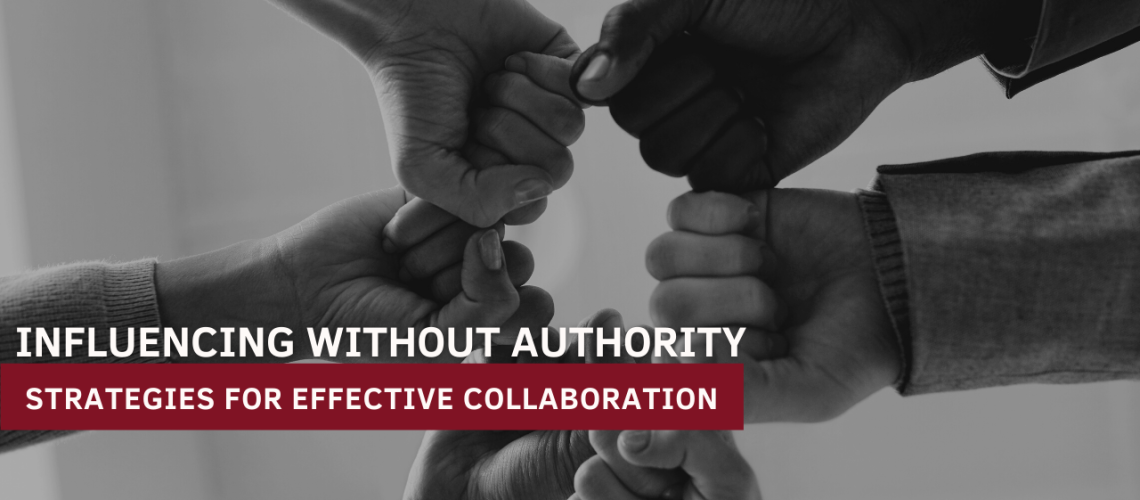By Dr. Salam Slim Saad
Unlocking the power of influence is a crucial skill for success in today’s collaborative work environments. Gone are the days when authority alone could drive results. Instead, professionals must learn to navigate complex networks and build connections, even without formal power. It’s not enough anymore to have “authority,” such as it is, in order to make a significant impact. To influence truly significant change, not just within an organization but in the world at large, you need to collaborate. Since hierarchies are often sources of conflict and confusion (not clarity) and power balance often favors the few — not the many — effectively collaborating without authority means taking advantage of today’s social networks and flattening the organizational structure as much as possible.
In this blog post, we’ll explore strategies for effective collaboration that go beyond traditional hierarchies and empower individuals to make an impact. Whether you’re leading a team or working within one, these techniques will help you foster cooperation, encourage buy-in, and achieve shared goals. So let’s dive in and discover how to become a master influencer – no authority required!
Establish Credibility
Establishing credibility is the foundation for influencing others, especially when you lack formal authority. To gain trust and respect from your colleagues, it’s important to demonstrate expertise in your field. This can be achieved by sharing relevant knowledge and insights that contribute to the success of the team or project.
Additionally, consistency plays a crucial role in building credibility. When you consistently deliver high-quality work and follow through on commitments, people begin to rely on you and see you as dependable. This reliability will help establish your reputation as someone who can be trusted to get things done.
Another way to boost credibility is by showcasing a strong work ethic. By going above and beyond expectations and demonstrating dedication to achieving shared goals, others will recognize your commitment and view you as a reliable team member.
Furthermore, communication skills are key when establishing credibility. Articulating ideas clearly, actively listening to others’ perspectives, and presenting information in a concise manner all contribute towards being seen as credible within the team.
Taking ownership of mistakes demonstrates integrity which further enhances one’s credibility. Admitting when something goes wrong shows humility and honesty – qualities that earn respect among peers.
Build Relationships
When working with others, it’s essential to establish connections based on trust and mutual respect. By investing time and effort in building relationships, you can create an environment that fosters open communication and cooperation.
One way to build relationships is by actively listening to others. Take the time to understand their perspectives, needs, and concerns. Show genuine interest in what they have to say, ask follow-up questions, and offer support when needed.
Another important aspect of relationship-building is being reliable and dependable. Be someone who follows through on commitments and delivers results. This helps foster trust among team members and demonstrates your commitment to the collaborative process.
Taking the initiative to connect with colleagues outside of work-related tasks can also strengthen relationships. Organize informal social activities or simply reach out for a friendly chat over coffee. These interactions help foster personal connections beyond professional boundaries.
In addition, showing appreciation for others’ contributions goes a long way in building positive relationships. Recognize people’s efforts publicly or privately, celebrate achievements together as a team, and express gratitude for their insights or assistance.
Remember that building strong relationships takes time; it requires consistent effort from all parties involved. By investing in these connections, you lay the foundation for effective collaboration built on trust, respect, and shared goals.
Develop a Shared Vision
When individuals come together with different perspectives and goals, it’s essential to create a unifying vision that everyone can rally behind.
To develop a shared vision, it’s important to foster open dialogue where team members can express their ideas and aspirations freely. This allows for the identification of common values and objectives that resonate with everyone involved.
Once these commonalities are established, it’s vital to ensure clarity by clearly articulating the shared vision in simple yet powerful terms. This helps align everyone’s understanding of what they are collectively working towards.
Additionally, involving team members actively in shaping the shared vision promotes ownership and commitment from all parties involved. By seeking input and incorporating diverse viewpoints, you demonstrate respect for individual contributions while fostering an inclusive environment.
Regularly revisiting and reinforcing the shared vision is also critical. As circumstances change or new opportunities arise, keeping this collective goal top-of-mind ensures alignment even during challenging times.
Developing a shared vision requires active collaboration and ongoing communication among team members. When everyone feels invested in the same purpose, achieving success becomes more attainable as each person contributes their unique skills towards a common goal
Facilitate Open Communication
When team members feel comfortable expressing their thoughts, ideas, and concerns openly, it paves the way for productive discussions and problem-solving.
To facilitate open communication within a team, it’s crucial to create a safe and non-judgmental environment where everyone feels heard and valued. Encourage active listening by giving each person an opportunity to speak without interruption or judgment. This ensures that all perspectives are considered.
In addition to creating a safe space, establishing clear channels of communication is essential. Whether it’s through regular team meetings, project management tools, or virtual platforms for remote teams, having designated avenues for sharing information helps keep everyone on the same page.
Another key aspect of facilitating open communication is fostering transparency. Sharing relevant updates about projects, deadlines, and challenges with the entire team promotes trust and accountability.
Moreover, leaders can encourage openness by being approachable themselves. By actively seeking input from team members and demonstrating receptiveness to feedback or suggestions through actions like incorporating them into decision-making processes fosters a sense of inclusivity.
Effective collaboration heavily relies on open lines of communication among teammates who feel empowered to express themselves freely without fear of repercussions or judgment. Investing time in cultivating this kind of environment strengthens relationships within the team while enhancing productivity levels overall.
Encourage Participation
When team members actively participate, they bring diverse perspectives and ideas to the table, leading to better decision-making and problem-solving. Here are some strategies to encourage participation in collaborative efforts.
Create a safe and inclusive environment where individuals feel comfortable expressing their thoughts and opinions. Encourage open dialogue and assure team members that their contributions will be valued and respected.
Actively seek input from everyone involved. Pose questions or challenges that prompt individuals to share their insights or suggestions. Show genuine interest in hearing different viewpoints and be receptive to alternative approaches.
Provide opportunities for active involvement during meetings or discussions. Assign roles or tasks that allow each person to contribute meaningfully. This not only encourages participation but also enhances ownership and accountability within the team.
In addition, acknowledge individual contributions openly by recognizing ideas or efforts publicly whenever possible. This recognition can motivate others to participate more enthusiastically.
Remember that effective collaboration requires active engagement from all participants. By encouraging participation through these strategies, you can foster an environment where every voice is heard and valued!
Promote Teamwork
When individuals come together and work towards a common goal, incredible things can be achieved. But promoting teamwork isn’t always easy, especially when you don’t have formal authority over others. So, how can you encourage a sense of camaraderie and cooperation among team members?
It’s important to create an environment where everyone feels valued and respected. This means listening to their ideas and opinions without judgment or criticism. Encourage open dialogue and foster an atmosphere of trust.
Establish clear goals and objectives that require collaboration from all team members. Make it known that achieving these goals will only be possible through mutual support and cooperation.
Additionally, provide opportunities for team building activities outside of work-related tasks. These could include social events or even dedicated time for brainstorming sessions where creativity is encouraged.
Furthermore, ensure that roles within the team are well-defined so that each member knows what is expected of them. This clarity helps prevent confusion or potential conflicts down the line.
Lead by example by actively participating in teamwork exercises yourself. By demonstrating your commitment to collaboration and showing enthusiasm for working together with others, you can inspire your teammates to do the same.
Remember, promoting teamwork requires effort from everyone involved but its rewards are immeasurable. Together as a cohesive unit, amazing results can be accomplished!
For any organization to thrive, hierarchy is not necessarily a guiding principle. Instead, transparency, collaboration and trust are the main drivers of success. Within any firm, there are no doubt leaders and followers, but a good manager should be able to find people who will rise to the occasion when tasked with lofty goals by displaying leadership qualities.
In today’s complex and interconnected world, the ability to influence without authority is becoming increasingly important for effective collaboration. By employing the strategies outlined in this article, you can position yourself as a trusted influencer and foster productive relationships with your colleagues.
Written by:



